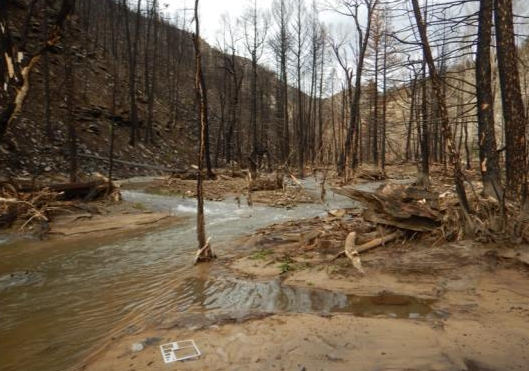Assessing Vulnerability of Reservoirs to Post-wildfire Sedimentation in the Wasatch Front

Over the past year, we have made considerable progress and remain on schedule with regard to our work plan and budget. In April, we published a peer-reviewed manuscript in Earth Surface Processes and Landforms, in collaboration with Jon Czuba, assistant professor of Watershed Engineering at Virginia Tech, that establishes the new modeling framework we have developed for this project (paper available upon request). The paper, and subsequent presentations, have been enthusiastically received by the academic community as a major breakthrough in predicting post-wildfire sedimentation.
In April, we also held a stakeholder meeting with representatives from the U.S. Forest Service, Natural Resources Conservation Service, Utah Division of Fire, Forestry and State Lands, and Salt Lake City Public Utilities to discuss the details of our project, as well as how we can best align our work with their agency’s management objectives and concerns. Discussion with the stakeholder group led to some changes in how we implement the model and we were also made aware of some new datasets that we will be able to use and new locations that would be useful to apply our model.
Leveraging the funding support provided by the Utah Public Lands Initiative, we were awarded a large collaborative grant from the National Science Foundation. This grant will provide three additional years of funding and allow us to replicate our analysis for all 133 large reservoirs (> 1000+ acre-feet) throughout Utah. Our work has also been recognized many times within the local and national media. In the past year, we have been interviewed about our project by Utah Public Radio, the Mountain West News Bureau, and numerous other newspaper outlets. Further, Utah State research associate Dr. Brendan Murphy was invited to present on this project at the Geological Society of America’s national conference in Phoenix in September.
Finally, we have hired an MS-level graduate student who will join our lab and start working on this project in October.
The paper we published in 2018 with funding from Utah Public Lands Initiative has been extremely successful and is ranked within the top 20 highest impact papers ever published by the American Geophysical Union’s prestigious journal Earth’s Future. This paper has begun to realign public perspectives to understand that increased occurrence of wildfire is an inevitable part of the foreseeable future in the western US and we need to better align development and risk assessment strategies with that future. The paper is available online: https://agupubs.onlinelibrary.wiley.com/doi/10.1029/2018EF001006
Associate Professor Patrick Belmont, Department of Watershed Sciences, Patrick.Belmont@usu.edu

